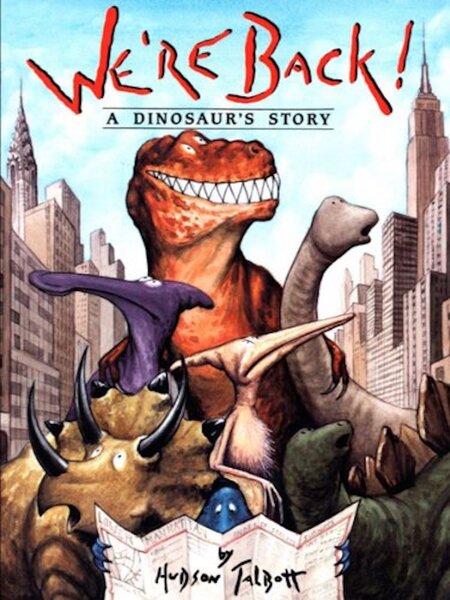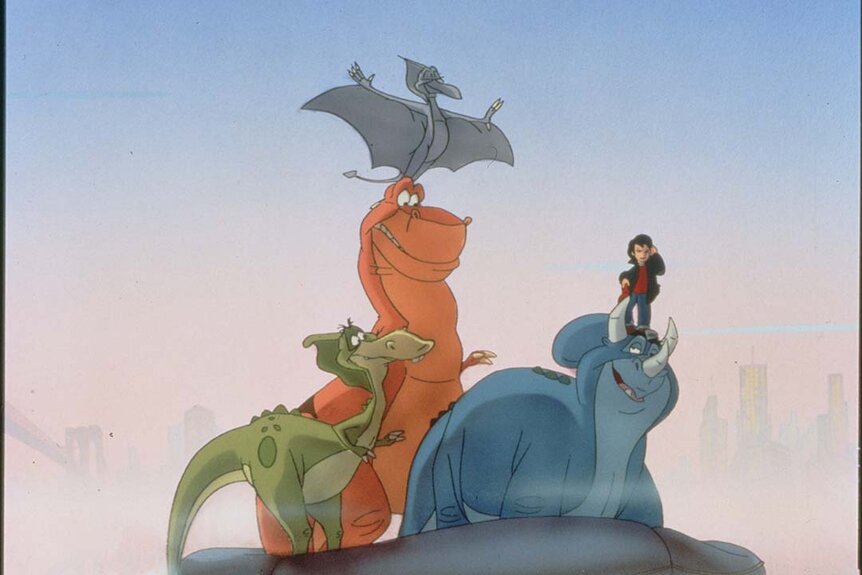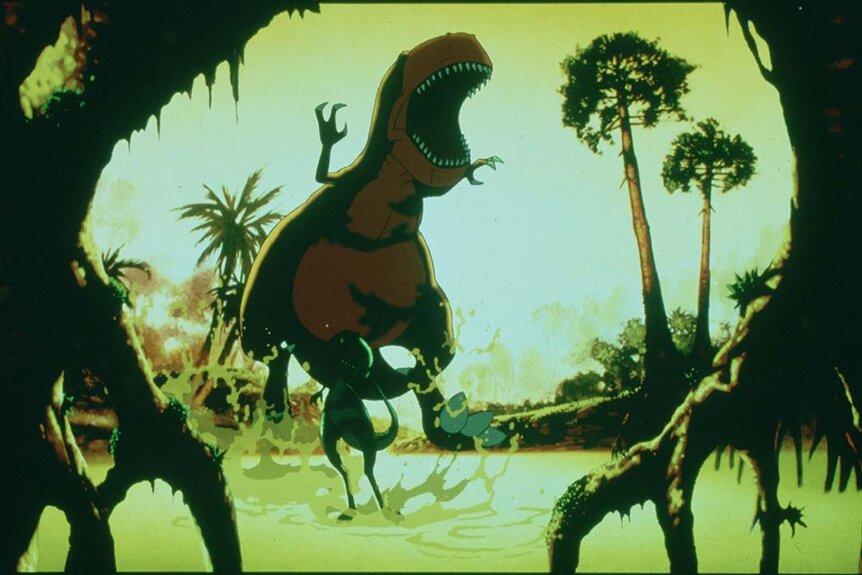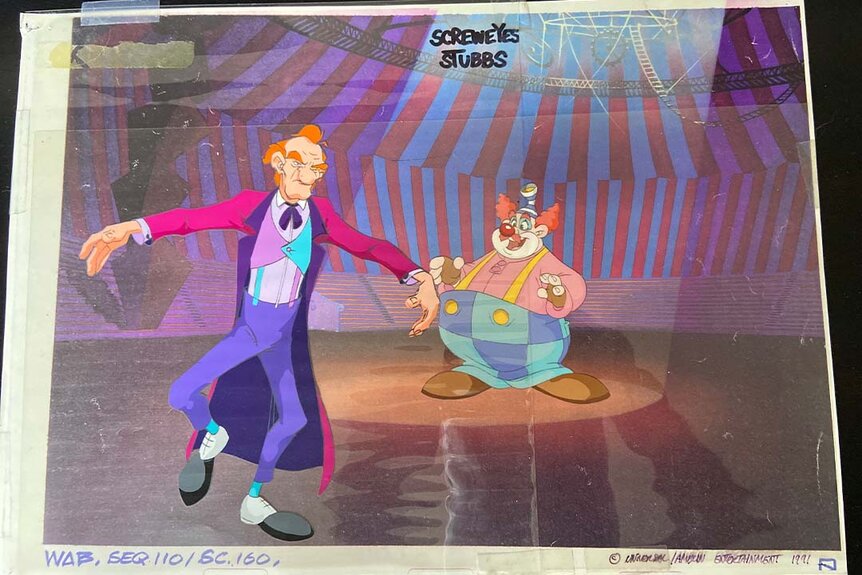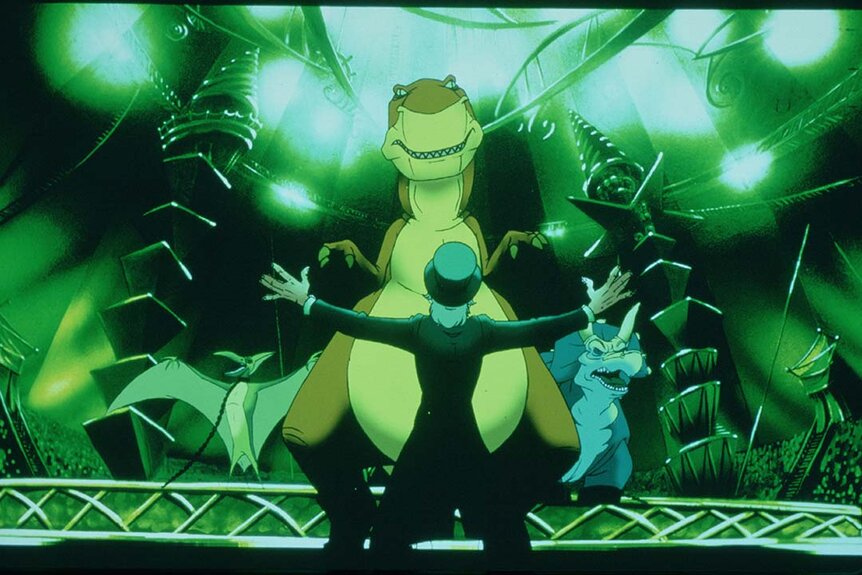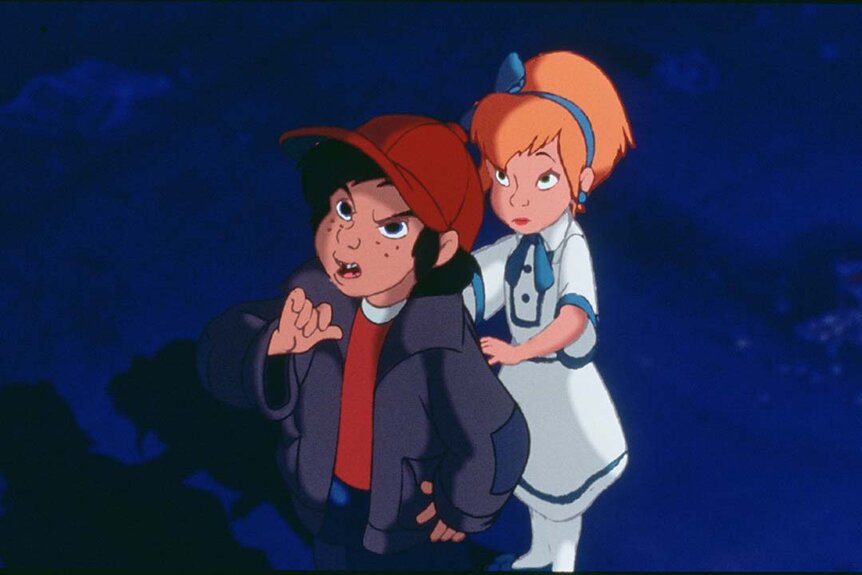Create a free profile to get unlimited access to exclusive videos, sweepstakes, and more!
Roll Back the Rock: An Oral History of We're Back! A Dinosaur's Story For Its 30th Anniversary
This criminally underrated gem from 1993 featured rare animated voice-over work by Walter Cronkite AND Julia Child!
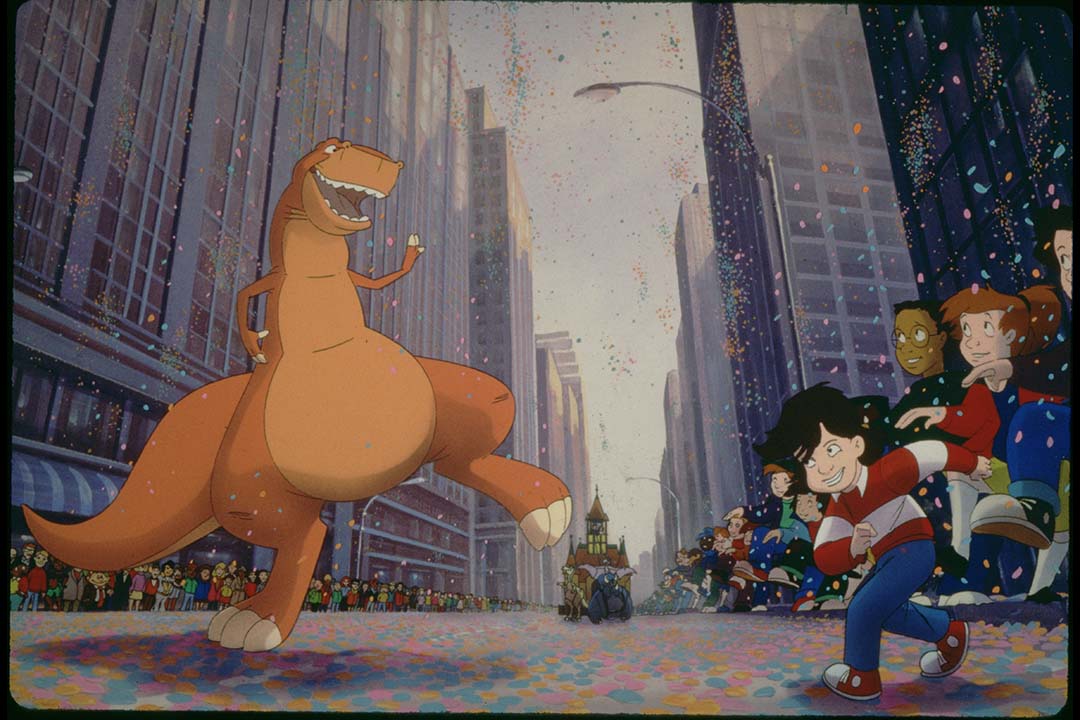
In 1993, Steven Spielberg stunned moviegoers around the globe with the incredible, lifelike dinosaurs of Jurassic Park. Less celebrated is another dino-centric movie he released that very same year — this one as far from realistic as it gets.
We're Back! A Dinosaur's Story, produced by Spielberg's now-defunct Amblimation studio and distributed by Universal Pictures, was marketed as a family-friendly alternative to the much more graphic Jurassic Park. But while the latter set box-office records and spawned a multi-billion dollar franchise that continues to this day, We're Back! (now available to own from Universal Pictures Home Entertainment) has unjustly slipped into obscurity, doomed to forever live in the Tyrannosaurus rex-sized shadow of its prehistoric predecessor.
RELATED: Jurassic Park's Assistant Director Reveals the 4 Big Lessons He Learned from Steven Spielberg
Loosely based on the 1987 children's book of the same name by author/illustrator Hudson Talbott, the movie follows a group of dinosaurs endowed with advanced brain power by a wise time traveler named Captain Neweyes (Walter Cronkite) and his alien assistant, Vorb (Jay Leno). The gaggle of primeval expatriates are dropped into modern-day Manhattan and tasked with fulfilling the wishes of dinosaur-loving children.
Things don't exactly as planned once Rex (John Goodman), Elsa (Felicity Kendal), Dweeb (Charles Fleischer), and Woog (René Le Vant) are sidetracked by a pair of young runaways, Louie (Joey Shea) and Cecilia (Yeardley Smith), looking to join a traveling circus run by Captain Neweyes' insane brother, Professor Screweyes (Kenneth Mars), and his clown companion, Stubbs (Martin Short).
Despite the fact that it was produced by the biggest name in Hollywood and featured an all-star voice cast — notable for the inclusion of non-actors like Cronkite as Neweyes and Julia Child as The Museum of Natural History's curator, Dr. Juliet Bleeb — We're Back! bombed critically and financially. Be honest: you probably forgot this movie even existed, right? But somewhere, deep down in your subconscious, you can still hear John Goodman belting out "Roll Back the Rock" during the Macy's Day Parade sequence.
With the highly underrated film celebrating its 30th anniversary this week, SYFY WIRE tracked down seven individuals who helped make this strange and amazing project a reality: author/artist Hudson Talbott; screenwriter John Patrick Shanley; co-directors Phil Nibbelink, Simon Wells, and Ralph Zondag; Amblin Creative Executive Douglas Wood; and "Roll Back the Rock" lyricist, Thomas Dolby.
The oral history of We're Back! A Dinosaur's Story
The saga of We're Back! begins with a satiric calendar Talbott published in the mid-1980s called Your Pet Dinosaur, which provided instructions on how to care for a domesticated dinosaur (the calendar later became a book in its own right).
HUDSON TALBOTT: A children's book editor saw it in Barnes & Noble, looked me up in the Manhattan phone book, and invited me to do a children's book. I had never thought of doing kids' books before, but that first one — We're Back! — was a hit and I've been doing them ever since! [Universal] called me and asked if I would be interested [in selling the rights] just a few months after the book came out. Surprisingly, they weren't the first. Hanna-Barbera had already reached me. Universal paid off Hanna-Barbera and bought the rights for Spielberg. He was very, very nice and extremely flattering. The only time we actually "worked" on it together was when they flew me to London to the animation studio they had there. He would call in every day from L.A. It was like the voice of God coming out of the speaker phone.
When it came time to adapt Talbott's book into a feature-length screenplay, writer Flint Dille (An American Tail: Fievel Goes West) was hired to pen the original draft. Douglas Wood describes this version as being "much lighter" than the end product released into theaters. Unhappy with Dille's script, Spielberg commissioned a new take from Academy Award-winner John Patrick Shanley (Moonstruck), who had previously worked with Amblin on 1990's Joe Versus the Volcano.
PHIL NIBBELINK: We had to take [Hudson Talbott's] little book, which basically had no villain and hardly any plot, and turn it into an 85-minute feature film with American movie structure. For him, that was a very painful and horrifying process to watch us try to expand his little cute idea into a full-blown thing ... He was always afraid that we were killing his baby, and, in a real sort of way, we were.
JOHN PATRICK SHANLEY: I read the children’s book and it was charming. Then I read [Dille's] screenplay and it really had jumped the tracks. It became all about homelessness, which just wasn’t what the book was about at all. It seemed to be about Thatcher’s England and the Liberal response to that ... I said, ‘Tell you what. I’ll write a scene, send it off to you, and see what you think. It’s gonna be very different from the [script] I just read.’ I wrote a scene about the big dinosaur, Rex, where he was golfing and he was sort of a crooner type, a Bing Crosby-type. Spielberg called me and said he liked that idea a lot. And so, I wrote the screenplay.
DOUGLAS WOOD: He [Shanley] took it in a darker direction, which I really liked. I think it's one of the weirdest animated features I've ever seen. Because it starts out based pretty faithfully to Hudson Talbott’s book and then it goes off on this really weird tangent into dark territory. I really like that and it's so unlike any other animated film that was being produced at the time.
Nibbelink and Wells were in the middle of directing Fievel Goes West, circa 1990, when they began storyboarding We're Back! Due to a lengthy gestation process and a major delay (more on that below), the animated feature ended up releasing five months after Jurassic Park, despite the fact that it went into production first.
NIBBELINK: Simon and I were pulling double duty, where we were directing the animators and the color and the production of Fievel Goes West, but we were boarding [We're Back!] at the same time.
WELLS: It was weird because, of course, we'd started making our dinosaur movie a long time before Steven even bought the rights to Jurassic Park. So we felt a little bit like, "Hey! We're making a dinosaur movie, now you're making a really, really big well-known dinosaur movie!"
SHANLEY: We were in pre-production and post-production simultaneously. That’s the only movie I remember having that experience on. Because it was Steven. Steven could just say, "Well, we’re gonna do another scene" and Universal would say, "Okay."
TALBOTT: We're Back! was started before Jurassic Park and took forever to finish. No matter. I thought the big wave of Dino-Mania had peaked long before, but I was wrong. It was still coming.
After Nibbelink and Wells storyboarded the film and put together a complete animatic, Spielberg asked them to begin development on an animated version of the Andrew Lloyd Webber musical, Cats. Brothers Ralph and Dick Zondag (veterans of Sullivan Bluth Studios, which made The Land Before Time and An American Tale) were then brought in to help shepherd We're Back! over the finish line. Even at this late stage in the game, though, Shanley continued to make changes to the screenplay at Spielberg's behest.
RALPH ZONDAG: We started around 1991 and were there for just under two years. We went right to the very end, pretty much. The whole picture was pretty much done ... There were a few sequences that we redid from scratch. If I were to give it a percentage, I’d say maybe 25-30 percent changed. But again, we were working off of what was existing. In some cases, you’re kind of patching holes, strengthening moments, and all that sort of thing. That is very much the animation approach, even Disney does that.
WOOD: I was the liaison between the production and Steven Spielberg ... In those days, you couldn't share files over your computers or anything, so we would get a package almost every day of the latest story reel animatic. I would do notes on the animatic and send those to Acton where the Amblimation studio was. I would do that when Steven wasn't shooting. But on the days that he was free, I would show him the animatics and we would go over them together. He would give me notes and I would relay them to the team.
ZONDAG: [Spielberg] had really creative ideas. He would go after moments in the film. There'd be moments in the film, and he would just say, "Okay, I think this is gonna be really special," and then he would just want to put all these bells and whistles onto it. There’s one scene where the the kids are doing their little wish fulfillments and they're all in bubbles coming out of the big radio. He really wanted to have that special moment happen ... He would always insert concepts and ideas. I don't know how he did it, considering how busy the guy is. We would get pages of notes waiting for us the next day or I’d get a phone call at four o'clock in the morning where he forgot tell me something, and forgetting that I'm in London at the time.
SHANLEY: It had been in the works now for quite a while. We’re in post-production and Steven keeps calling me and saying, "I have another idea about this scene." And off I’d go. Finally, I got a call from Frank Marshall and it’s the only call I’ve ever gotten like this my entire history in show business. Frank was the producer on the film and he said, "John, ask me for more money." I said, "What…?" He said, "You’re still writing the movie. We’re in late post-production and you’re still writing. Ask me for more money." So I said "Okay," demanded some more money [laughs], and he got me some more money."
When the animated Cats ultimately fell apart, Nibbelink returned to complete We're Back!, while Wells moved on to the final Amblimation release: 1995's Balto. Ralph shifted over to Disney, where co-directed 2000's Dinosaur. Dick, however, stayed in the Amblin fold and was soon paired up with Nibbelink for a second stab at Cats, which also never materialized.
ZONDAG: Our contract came to an end, and they [Phil and Simon] came back and finished the movie. But it was a great opportunity to work with Spielberg. That opened the doors for directing on films, so I always look back at it as really cool to have had that chance.
WELLS: We split up at that point and Phil really [carried] the lion’s share of the work on We’re Back! My involvement with that basically ceased completely. I got into developing Balto and getting that off the ground and Phil took the movie all the way through finishing it, through post-production and all that part of it.
NIBBELINK: Steven pushed [back] the release date and added a million dollars' worth of changes. We went back and fixed a lot of things and changed a lot of stuff, did a lot of repair work in there. Part of the thing that created the repair work was we screened it for an audience. We had a test screening at Universal and [then-studio head] Sid Sheinberg was there, and we listened to the focus group. The focus group hated the film. And so, Sid Sheinberg pressured Steven into making a lot of big changes.
One of the biggest changes/additions turned out to be the film's most memorable sequence, in which Rex and his fellow dinosaurs pretend to be inanimate floats during the Macy's Day Parade. But when he overhears the children below wishing that he and the others were real, the genial T. rex is unable to help himself and breaks out into song. Thomas Dolby wrote the track — entitled "Roll Back the Rock (To the Dawn of Time)" — alongside composer James Horner.
WOOD: That was added when everyone realized, "This movie needs to be more fun." So we created that big musical scene. It was actually choreographed with an actual dance choreographer. I can’t remember her name now. But Steven wanted a song and a sequence that kids could replicate on their own. He wanted it to become like a dance craze.
DOLBY: James was not really a pop or rock songwriter, per se, so he asked me to come in and help out ... I listened to a bunch of marching band music and I noticed that a few of them had what we know as the Bo Diddley beat. And so, I decided to use that as the basis. I went straight to the lyrics after that and wanted the lyrics to tell the story of the main characters. We didn't know at that point who was going to be the eventual voice singer that I would work with. I just did that with fairly minimal input from James Horner. I made a demo of it using my own equipment and then he took that and orchestrated it for for the final version ... John [Goodman] was less of a professional singer than the others, so it took quite a lot of post-production, editing, and splicing together different takes to get a good tape. But, of course, it had great personality and really fit in the scene, given that his character was the singer.
Two renditions of "Roll Back the Rock" appear in the film: the main version performed by John Goodman and a cover by Little Richard that plays over the end credits. However, SYFY WIRE can exclusively reveal that Tom Jones was originally hired to sing the cover. A final recording of the Jones version does exist, though we aren't able to share it here for obvious reasons.
DOLBY: I had a friend called Paul Kreppel, an actor and Broadway performer, who did the initial demo for me. We took that to Tom Jones, who recorded the second version, which was fabulous — especially the spoken intro to the song. But Tom Jones had just signed a new record deal and his record company didn't really want this coming out and taking the wind out of the sails of his latest album. So we recorded it and completed the Tom Jones version, only to find out that we weren't gonna be allowed to use it.
WOOD: Little Richard did a fantastic job, but Tom Jones really made it his own and it was really great ... [Thomas] and Little Richard had great rapport. Both were perfectionists, determined to get the best out of the song as was humanly possible. Little Richard was kind and centered. I didn't get a glimpse into his flamboyant side, other than the delightfully flashy clothes he was wearing.
Other changes included the deletion of content deemed too scary for young audiences, so the film could land a G rating. The largest segment effected was Professor Screweyes' fear-based circus. No surprise there.
SHANLEY: He had this kind of infernal machine that played music. It was playing a distorted dark version of the "1812 Overture" and making bad things happen. They showed it to the motion picture board and they said, "Not suitable for children. That’s too scary." So this rather large beat of the film had to be excised. [Similarly], the demise of Screweyes had to be toned down.
WOOD: We did a test screening and it tested poorly. Someone at the screening was part of some Christian family organization and they noticed that there was a pentagram on the floor during the Grand Demon Parade, so we had to go back and digitally remove that from the floor, because everyone was saying this movie had subliminal Satanic influences. I think we had to remove a few other things, because it was going to get a PG rating.
ZONDAG: [Spielberg] wanted us to go to Vegas because at that time, the Siegfried and Roy show was the big show there. He said, "The lighting is spectacular, you really got to see it." Because he wanted to incorporate some of that lighting for the big circus act.
(Check out an exclusive, never-before-seen animation cel featuring Screweyes and Stubbs below)
As stated earlier, the voice cast for We're Back! is absolutely packed with talent, including people you'd never expect to hear in a kids' movie — mainly news anchor Walter Cronkite and legendary chef Julia Child. How these 20th century icons came to be considered for the movie is a slightly contested matter, with differing accounts from various crew members.
NIBBELINK: I [did] most of the voices for the animatics. I can do a Julia Child and I can do a Walter Cronkite. And, so when it came time to put voices to our storyboards, I would do those voices and it made Steven laugh. So he said, "Fine, let's just go with those guys."
SHANLEY: No matter how much time you spend around Steven, you forget who he is. He said, "What were you thinking [in terms of the cast]?" I said, "Well, I was thinking about the Museum of Natural History curator being Julia Child." And he calls up Julia Child. I just didn’t expect him to do that. I was just like, "I meant somebody like Julia Child. I didn’t mean Julia Child. Although I’m thrilled, I’m just very surprised that you actually got her to do this." The same thing happened with Captain Neweyes."
WOOD: The development team would sit around and when the script came in, we would [brainstorm]: "What would be fun for these roles?" I can't remember who came up with them. I don't think it was Steven, but amongst our group, we came up with those choices.
WELLS: We traveled around a great deal to get people. Because we were based in London, we'd fly out to L.A. for three or four days and have back-to-back recording sessions with people.
Of course, there were plenty of amazing behind-the-scenes anecdotes from the recording process...
WELLS: I remember John Goodman, bless him, came in and he just had his wisdom teeth removed the day before and he was in real pain. You wouldn't know from his performance, but he was great. Anytime between takes, he was just there kind of nursing the side of his face. I felt so sorry for him.
ZONDAG: His cheeks were [swollen] and he was not in the best of moods. I remember him being a little cranky. Not cranky to us, but I could tell that he just wanted to get through this and get out.
WELLS: I was more excited about working [with] Felicity Kendal, because she'd been a television star from my youth and I'd even actually approached her about doing a voice for a student film I did, or was planning to do. I wanted to get her to read a little story and she politely refused, so it was actually kind of a minor victory to get her as a voice talent on We're Back!
NIBBELINK: We recorded [Walter Cronkite] on a Saturday morning in downtown New York. It was our policy, Simon and I, where we would fly to wherever the actor was and that took us all over the world ... When we got there, it was in a skyscraper and it was a 9 o'clock [am] recording session and the doors were all locked downstairs. There was porter who let us in and we went up and we met the engineer who was there, we got all set up, and then we waited for Walter Cronkite.
And we waited and we waited ... We had no way to communicate with him on a Saturday because the people we had communicated with before were his agent and stuff, so they were not at work. Finally it dawned on me, "Maybe he couldn't get in downstairs." So I went down to the street level and sure enough, there he is — cold and huddled up against the sidewalk. I let him in, he was just mad as hell. My first meeting with Walter Cronkite was to meet with a grumpy, cold, old man, and I had to apologize up one side and down the other and warm him up; get him some coffee, jolly him up, basically bring him back to life before we could record the session.
WOOD: [Cronkite] was very businesslike and professional, and probably came in as if he was recording a new story. He didn't particularly have a sense of playfulness. I guess you wouldn't attach that quality to Walter Cronkite in the first place.
ZONDAG: He wasn't used to doing voiceover work, so he didn't want to give you a big range of work because he’s not an actor. He would just deliver his lines [and say] "Is that good enough?" He was great.
NIBBELINK: When I was directing [Julia Child], the first line is "the dinosaurs knock on the door," and she's supposed to yell — she's way off in the back of the museum — "I'm coming! I'm coming!" The first time she read it, she said [in a stately and quieter voice], "I'm co-ming, I'm co-ming." I said, 'Well, you're in the back of the museum and you're running, can you please yell and project [copying her voice] "I'm coming! I'm coming!'?" She said, "Well, you don't want me to do it in that silly cartoon voice, do you?" And I went, "No, I'm sorry. Please, just do it as it you naturally would." She says, "I thought not!”
WOOD: The person who impressed me the most in terms of the sound recordings was Martin Short ... I've never seen an actor work so hard in my life. By the end of the session, he was dripping in sweat. He was probably the only actor who seriously improvised with the lines. But everything he did was gold and he had a great sense of humor. He was just totally committed to it.
NIBBELINK: [Jay Leno] showed up at the recording studio and we got to get to know him. Interestingly enough, when he's not on stage, he's very, very shy and talks in a low tone. He always wears the same clothes, jeans and a blue denim shirt. So he shows up in these jeans and he's hunched over and talking in a whisper, in a very low voice. Then I give him the script and we say, "Okay, rolling." And he says, "Are we rolling?" I go, "Yes." He goes, "Hey! My names Vorb, how are you?!" A completely different personality."
WELLS: This was right around the time when Jay Leno was just exploding. I think he'd just taken over doing [The Tonight Show], and so we got him and then he was a huge name doing this little tiny part. But he was great fun, he really enjoyed it.
WOOD: He had just become the replacement for Johnny Carson, so he was really new to that. He wasn't a household name yet. He was known as a good standup, but he wasn't a talk show host until right before he did the session for We’re Back! So he was actually very preoccupied because he was a perfectionist and really needed to get back to his studio to tape that night’s show So we didn't spend a lot of time with him. I remember it was a really quick session because he was so concerned about getting back to do his show. Obviously, you have to prioritize and at that point, that really was the priority in his life, justifiably so. But he was funny. He was one of those guys who just kind of snapped into character all of a sudden once the microphone was in front of him.
Both John Malkovich and Christopher Lloyd were cast as Professor Screweyes before Kenneth Mars (best-known as Friedrich Kemp in Mel Brooks's Young Frankenstein) got the role.
NIBBELINK: We first recorded John Malkovich to play it and he delivered such a dark and dangerous performance that Steven didn't like it and thought it was too scary. So we said, "How about Christopher Lloyd?" He liked that because Christopher Lloyd gives sort of caricature performances. I was in London and our producers were in L.A. and we all flew to Boston, where Christopher Lloyd was in a play that summer. We all got to the recording studio, and we're all sitting there, waiting. And waiting and waiting. He never showed up. Many hours later, we finally found him [but] he couldn't do it, so we all flew back to London and L.A. and we came out the next weekend to record him again. That time he showed up and delivered a great performance, but Steven didn't like it.
WOOD: When we saw the footage, paired with [Malkovich's] voice, everyone felt that it was too creepy. You should hear it. I wish I had a copy of it, it was fantastic. He was really, really scary. So then he was replaced by Christopher Lloyd ... We got to the studio early in the morning and he just wasn't there. So we called his agent and the agent said, "Well, he should be there." We waited around and waited. He was in a play in Boston, so we contacted theater and they didn't know where he was. We ended our trip there [and went back home]. Eventually, we found out that he had a really bad cold and he was in bed or something. So we had to come back and record him. He just sounded like the character from Back to the Future and a little bit of Jim Ignatowski from Taxi. So we replaced him with Kenneth Mars, who did a really good job.
Some errant casting fun facts about the casting before we move on: Shanley floated Mickey Rooney for the role of Captain Neweyes, but the idea never went anywhere because Rooney was considered "too difficult." Second is that Alien star Yaphet Kotto was originally cast as Woog, the hot dog-loving Triceratops, but had to drop out after a single session. Thirdly, the late Larry King makes a brief appearance as himself fielding radio calls about dinosaur sightings in New York City.
WOOD: [Spielberg] had the idea to bring Larry King in. He wanted it to really capture the feeling of New York. And he thought, "Well, Larry King is just quintessentially New York." So he brought in Larry. And then at the recording session, we just wanted Larry to get a typical conversation going with a call-in person and he was a little uncomfortable since it wasn't scripted. I have a background in improvisation, I used to be with Second City in Chicago, so I did some improvs with him of callers calling in. It was a lot of fun.
As We're Back! neared its November '93 release date, Universal Pictures marketed the movie as "A dinosaur adventure for the whole family." Sadly, the animated outing failed to match the box office might of Jurassic Park, netting just over $9 million.
WELLS: Rather famously, Steven had not allowed his own children to see Jurassic Park because he felt it was too violent for small kids. So he was a good sport in saying, "But we're making a dinosaur movie that the kids can enjoy!"
NIBBELINK: We were all hoping that we were creating a dinosaur craze and, unfortunately, when We're Back! came out, we couldn't get the same people [who saw Jurassic Park] to go see the movie. It was very frustrating.
ZONDAG: I would have loved to have a little more pushback on the storytelling itself. I would have loved to try to figure a few things out so the focus could be a little more narrowed down to one character. If it’s Louie’s story, then make it Louie’s story a little more clearly. Because in hindsight, it felt a little too ensemble-like. Every character has to have their own little thing and it really needed to be mustering around one particular storyline a little bit better. I would have liked to maybe hone that just a bit better than it was.
TALBOTT: I haven't seen it since the screening in New York City. That was a lovely gesture on Steven's part: they organized a private screening for me with my own guest list of 150 friends, buddies, and professional colleagues. Great party afterward in my loft!
To celebrate the movie's Thanksgiving weekend release, Universal debuted a custom Rex balloon for the 1993 Macy's Day Parade. Measuring 84 feet in length, it was the longest inflatable that year. Rex's dominance turned out to be short-lived once the balloon hit a traffic light and deflated. Ironically, Hudson Talbott got a front row seat to the incident.
TALBOTT: A friend was taking pictures of me with the balloon and then suddenly, the parade started. I got caught with a rope in my hands and no exit! And sure enough, when we got to Columbus Circle, the winds picked up and blew the balloon right into a light pole, deflating it.
Over the last three decades, We're Back! has accrued a passionate cult following, mainly comprised of viewers who enjoyed watching the film as children. "I seem to be alone in my love for this one," Slash Film's Dalin Rowell wrote in 2017. If you feel that way, we're here to tell you you're not alone. To quote the great Tobias Fünke, "There are dozens of us!" But what makes this film so special to those who continue to cherish it all these years later?
WOOD: I think the greatest films for kids are ones where it's not necessarily a moral lesson. If you look at great literature for kids like Alice in Wonderland, [which] was subversive in many ways, and Roald Dahl as well. He did darker stories and they were ones where kids were empowered and the adult world was kind of antagonistic ... When films become really moralistic and tell kids, "This is what you should do" or "This is how to behave," they're not nearly as interesting as movies where kids are given free rein and you see very little of the adults, which is kind of like We’re Back! The Wizard of Oz, is one of the greatest movies ever made, and that was quite a bit scary. I had nightmares about that when I was a kid. Kids love to be scared and one of the things about We’re Back!, is that by showing a scary world, it prepares kids to navigate that world. If you just shy away from those issues and have a real safe, bland world, that's not the world that kids are a part of. They need the tools to learn how to deal with a world that's not always nice and pretty and clean.
SHANLEY: It’s not a cookie-cutter, formulaic children’s movie. It’s its own animal — both because Hudson Talbott was an original and because I do original work as well. We just told a story made out of the imaginations of two people with a little extras coming in from Spielberg. It really does have an author and a lot of children’s movies are very collaborative and end up being written by 15 people. That did not happen with [this] film. It’s a very individual voice ... The thing that I didn’t really understand was that this was gonna be part of some people’s childhoods. It was only many years later I started to hear from people that [We're Back!] had been part of their childhood. Nothing else I had wrote was like that. I didn’t affect that time in a person’s life that much. I realized much later just how precious that is and how special it is to get to be part of people’s childhoods for real.
DOLBY: In a way, it sort of predates the discovery of anime and Studio Ghibli-type animated films by a Western audience. There's a strong influence there from that world and I think it was maybe a little bit ahead of its time, stylistically. It happened at a time when the box office was going more towards the Pixar approach and this film doesn't really fall in with that movement.
ZONDAG: There’s a quirkiness to it. It’s just different. I think it’s an interesting idea and then you have the spookiness of the circus act. It’s just different, something you wouldn’t see.
WELLS: I think about movies that I treasure and I realize [that] sometimes, it’s very much about where you were or when you saw them. It was probably at that moment when you were just kind of getting into dinosaurs and this was a bunch of friendly dinosaurs and wouldn’t it be cool if you were that kid getting to hang out with these friendly dinosaurs? The film has a warm and fuzzy feeling that relates to where you were in your own personal development at the time.
TALBOTT: Fans still find me and often ask how to get a copy of We're Back! And to all of them I say "THANK YOU."
We're Back! A Dinosaur's Story is now available to purchase from Universal Home Entertainment.
